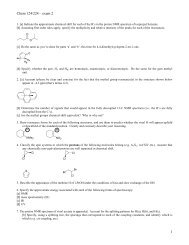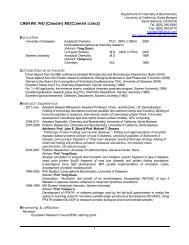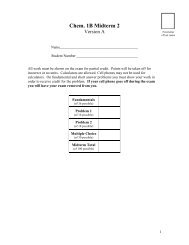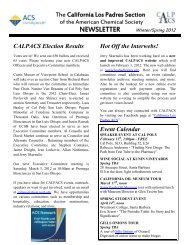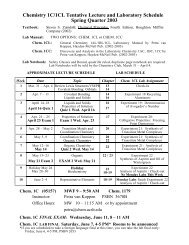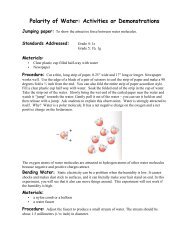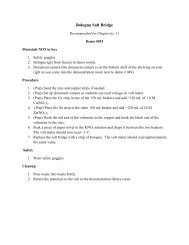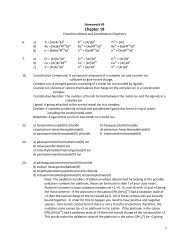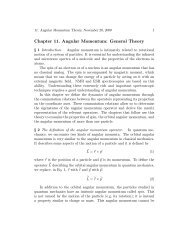Synthesis and Characterization of CdSe Nanocrystals ( ) ( , , ) 8 h ...
Synthesis and Characterization of CdSe Nanocrystals ( ) ( , , ) 8 h ...
Synthesis and Characterization of CdSe Nanocrystals ( ) ( , , ) 8 h ...
You also want an ePaper? Increase the reach of your titles
YUMPU automatically turns print PDFs into web optimized ePapers that Google loves.
<strong>Synthesis</strong> <strong>and</strong> <strong>Characterization</strong> <strong>of</strong> <strong>CdSe</strong><strong>Nanocrystals</strong><strong>Synthesis</strong>Add 75 mg <strong>of</strong> Li 4 [Cd 10 Se 4 (SPh) 16 ] to a crimp topvial containing a magnetic stir bar. Seal the vial <strong>and</strong>purge with argon for 2-5 minutes. Transfer 5 mL <strong>of</strong>molten hexadecylamine 1 that is stirring under anargon atmosphere via syringe to the vial. Place thevial in an aluminum heating block <strong>and</strong> raise thetemperature to 200 o C. Over the course <strong>of</strong> severalhours the solution will change from colorless toyellow. You may remove the vial at this time <strong>and</strong>allow to cool. If larger diameter particles are desired,the temperature is raised to 220oC <strong>and</strong> allowed to stirovernight. Raising the temperature further (230 o C)<strong>and</strong> allowing the mixture to stir for up to a week willresult in larger particles. The solution will changefrom yellow to orange to red as the particles grow. 2If the solution turns cloudy at any time, decrease thetemperature to 190 o C until the solution becomesclear. The temperature is raised to the previous point<strong>and</strong> the growth is allowed to continue.Remove 0.5 grams <strong>of</strong> the waxy material <strong>and</strong>place it in a test tube. Heat the test tube in a waterbath until the wax has melted. Add 2-3 mL <strong>of</strong>methanol to the liquid. The <strong>CdSe</strong> nanocrystalsshould precipitate at this point. Place the test tube incentrifuge <strong>and</strong> spin the solutions for ~5 minutes.Note: The centrifuge must be balanced for safe use.Tubes opposite each other in the centrifuge rotormust have the same mass. Check the tubes beforeyour turn on the centrifuge. After spinning, decantthe liquid <strong>and</strong> then add 1-2 mL <strong>of</strong> toluene to theremaining solid. The result should be a suspension <strong>of</strong>nanocrystals in toluene.Figure 1. Optical absorbance spectrum <strong>of</strong> <strong>CdSe</strong>. Thearrow indicates the λ max for the exciton.Theoretically, the exciton absorbance shouldcorrespond to the confinement energy <strong>of</strong> a particle ina three dimensional box. This is indeed the case asshown in figure 2 where the lowest energy excitonabsorption shifts to longer wavelength withincreasing particle size. The confinement energy <strong>of</strong> acharged particle in a cubic box is given by theequation below. The potential energy is defined asinfinite outside the box <strong>and</strong> zero inside. This is athree dimensional extension <strong>of</strong> a particle on a line inan infinite potential well.2 2 2 2h ⎡∂ ψ ∂ ψ ∂ ψ ⎤E( ψ) = U( x, y, z)ψ −2 2 2 28πm⎢ + +dx dy dz⎥⎣⎦<strong>Characterization</strong>Record the absorbance spectrum <strong>of</strong> yournanocrystal solution. Determine the wavelength(λ max ) <strong>of</strong> the exciton peak. The exciton peak isidentified in the <strong>CdSe</strong> optical spectrum shown belowin figure 1. In a semiconductor absorption <strong>of</strong> light <strong>of</strong>a sufficient energy causes an electron to move fromthe valance b<strong>and</strong> to the conduction b<strong>and</strong>. In theprocess a hole (positive charge) is created in thevalence b<strong>and</strong>. An exciton is analogous to an excitedstate in a molecule.Figure 2. Absorbance spectra <strong>of</strong> various sizes <strong>of</strong><strong>CdSe</strong> nanocyrystals.The exciton in a semiconductor nanocrystal can bethought <strong>of</strong> as a real world example <strong>of</strong> the particle in abox problem, however there are some significantdifferences. First the nanocrystal is not a cubic shape.1
Experiments reveal that the shape is better thought <strong>of</strong>as ellipsoidal. The equation above can be modifiedto account for this geometry. Another importantdifference is that the optical transition we observe asthe exciton b<strong>and</strong> results from the creation <strong>of</strong> twocharged particles; an electron(-) <strong>and</strong> a hole(+). Thistoo can be accounted for <strong>and</strong> the Hamiltonian can bewritten for the electron <strong>and</strong> hole 3h hH =− ( , )2 28π∇ − 8∇ +2 22 2e hU Se Shmeπ mhwhere m e <strong>and</strong> m h are the effective masses <strong>of</strong> anelectron <strong>and</strong> a hole in <strong>CdSe</strong> <strong>and</strong> S e <strong>and</strong> S h are thepositions <strong>of</strong> the electron <strong>and</strong> hole inside thenanocrystal. Now the potential energy is consideredinfinite outside <strong>of</strong> the nanocrystal but inside coulombattraction between the oppositely charged particlesmust be taken into account. Including the appropriateterms leads to the following equation known as theeffective mass model2 2h ⎡ 1 1 ⎤ 1.8eE*≅ Egap+2 ⎢ + ⎥−8R ⎣memh⎦4πεRwhere E gap is the bulk <strong>CdSe</strong> b<strong>and</strong>gap energy <strong>and</strong> ε isthe dielectric constant <strong>of</strong> <strong>CdSe</strong>. The effective massmodel is good for particles above ~7 nm in diameter.For smaller particles the approximations made inreaching the effective mass model are no longervalid. Research is currently underway to develop amore general theory. Optical characterizationmethods can still be utilized to determine the size <strong>of</strong>nanocrystals. Extensive data have been collected tocorrelate the exciton energy <strong>and</strong> the particle size.Particle sizes are determined by SEM images <strong>and</strong> x-ray powder diffraction techniques (see figure 3).The line through the data is an empirical fit <strong>and</strong> canbe used to estimate the diameter <strong>of</strong> <strong>CdSe</strong>nanocrystals using the following equation1−BλD = A + C λwhere D is the diameter <strong>of</strong> the nanocrystal (nm), λ isthe exciton wavelength (nm) <strong>and</strong> A = -0.79196, B =3.8121 × 10 -3 <strong>and</strong> C = 9.5125 × 10 -4 .Use the equation above to determine the size <strong>of</strong>your nanocrystals. To explore the idea <strong>of</strong> particle ina box further we will look at the emission energy as afunction <strong>of</strong> particle size. Record the emissionspectrum <strong>of</strong> your nanocrystal solution. Use the lmax<strong>of</strong> the lowest energy exciton as the excitationwavelength. To avoid saturating the detector startcollecting data 10 nm to the red (longer wavelength)<strong>of</strong> your excitation wavelength. Record the emissionmaximum in your laboratory notebook <strong>and</strong> on thechalk board in the lab. The class data will be postedto the web at the end <strong>of</strong> the week. The particle in abox model predicts that the emission energy shouldbe proportional to 1/R 2 . Therefore a plot <strong>of</strong> theemission energy (in eV) vs. 1/R 2 should result in astraight line. Plot the class data <strong>and</strong> discuss theresults.1 Hexadecylamine is a waxy substance at roomtemperature (m.p. = 60 o C). Melt the solid in a threeneck round bottom flask fitted with a rubber septum,a thermometer <strong>and</strong> a reflux condenser. Heat theHDA until the temperature is ~140 o C. Evacuate theflask several times to remove any residual water.2 The cooled vials will turn much lighter in color asthe cool. An orange solution will result in a yellowsolid.⎡∂ ψ ∂ ψ ∂ ψ ⎤⎢dx dy dz⎥⎣⎦2 2 23 2∇ = + +2 2 2Figure 3. Plot <strong>of</strong> <strong>CdSe</strong> diameter vs. excitonabsorbance.2



